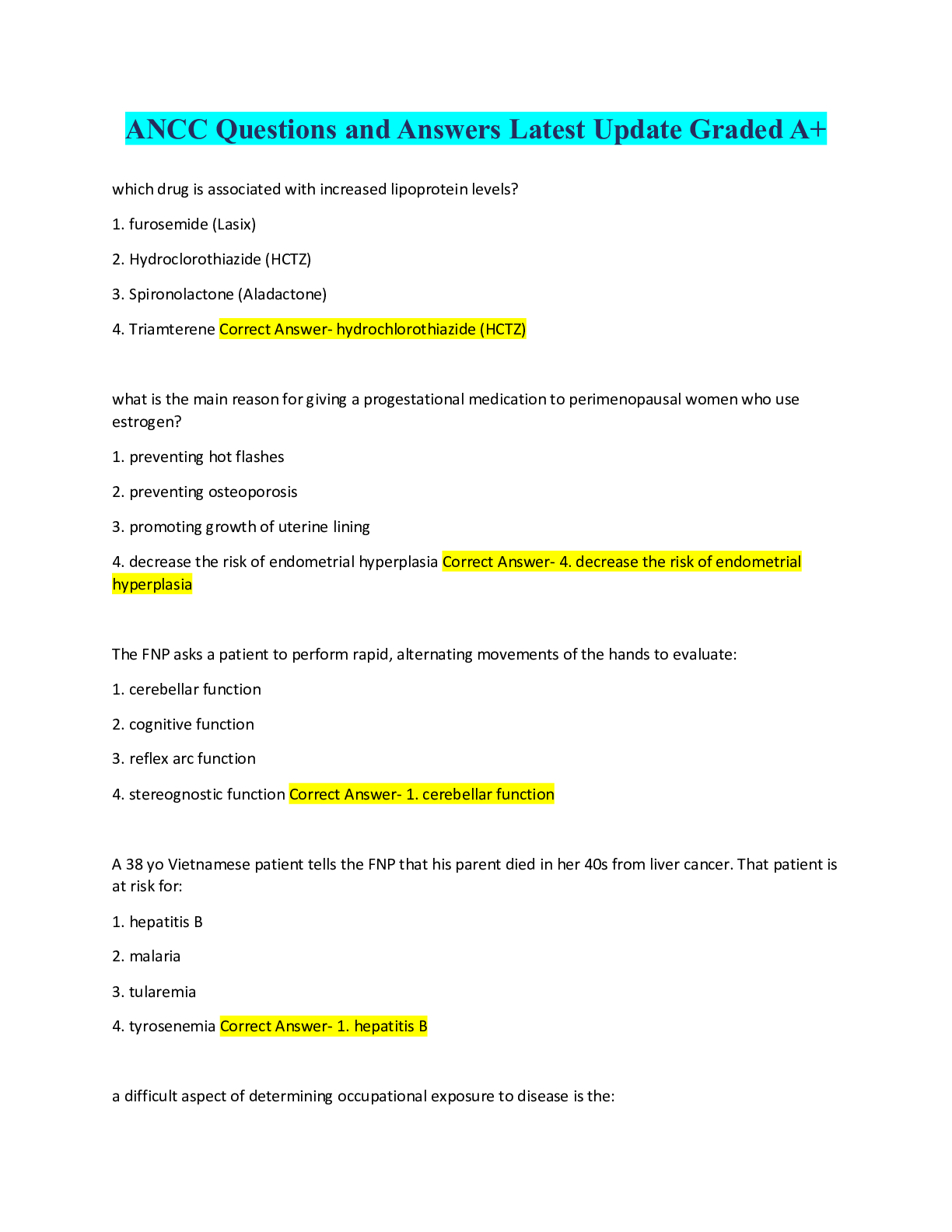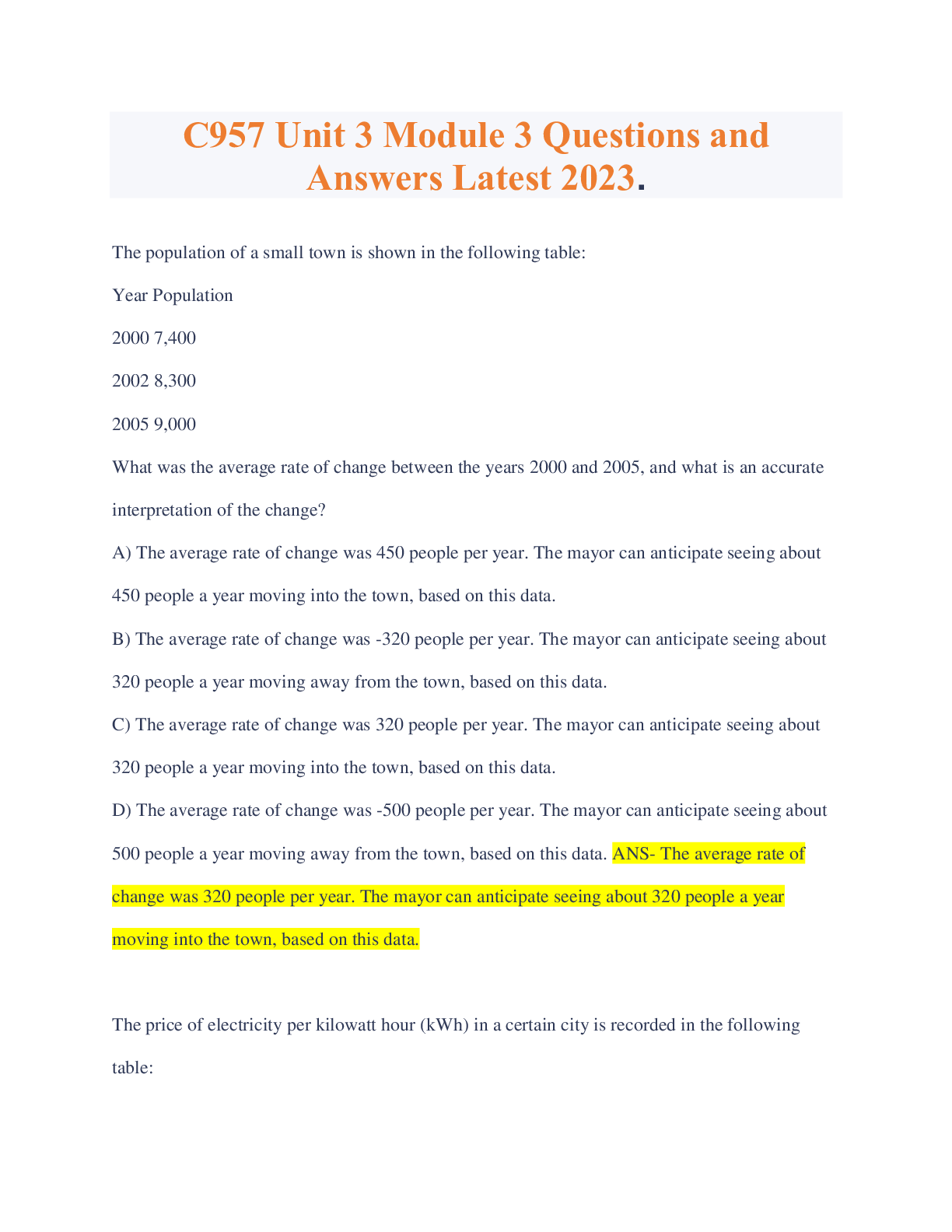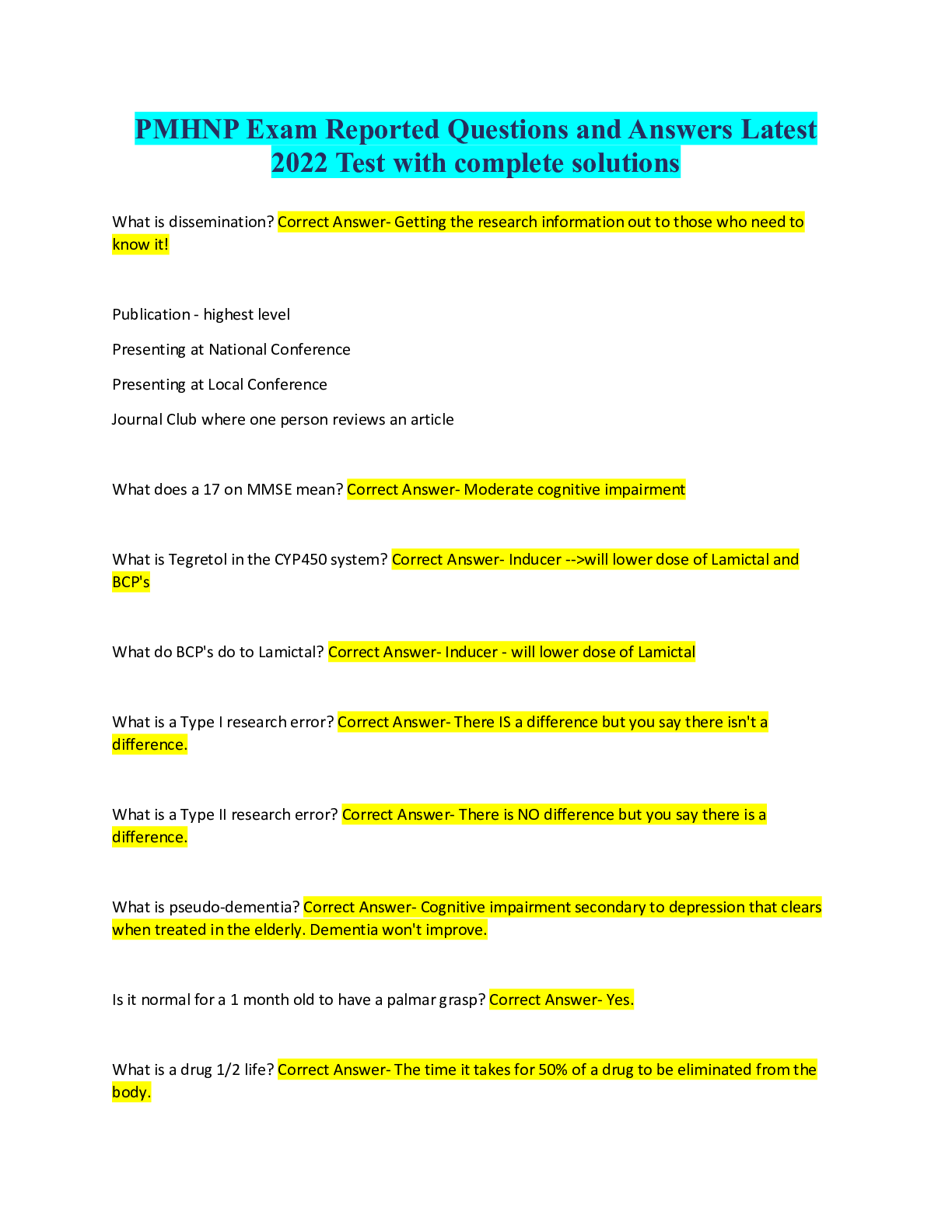*NURSING > QUESTIONS & ANSWERS > ANCC Questions and Answers Latest Update Graded A+ (All)
ANCC Questions and Answers Latest Update Graded A+
Document Content and Description Below
ANCC Questions and Answers Latest Update Graded A+ which drug is associated with increased lipoprotein levels? 1. furosemide (Lasix) 2. Hydroclorothiazide (HCTZ) 3. Spironolactone (Aladactone) 4. ... Triamterene Correct Answer- hydrochlorothiazide (HCTZ) what is the main reason for giving a progestational medication to perimenopausal women who use estrogen? 1. preventing hot flashes 2. preventing osteoporosis 3. promoting growth of uterine lining 4. decrease the risk of endometrial hyperplasia Correct Answer- 4. decrease the risk of endometrial hyperplasia The FNP asks a patient to perform rapid, alternating movements of the hands to evaluate: 1. cerebellar function 2. cognitive function 3. reflex arc function 4. stereognostic function Correct Answer- 1. cerebellar function A 38 yo Vietnamese patient tells the FNP that his parent died in her 40s from liver cancer. That patient is at risk for: 1. hepatitis B 2. malaria 3. tularemia 4. tyrosenemia Correct Answer- 1. hepatitis B a difficult aspect of determining occupational exposure to disease is the: 1. confidentiality of the information in company records 2. inaccuracy of disease reporting 3.long latency period between exposure and disease development 4. reliance on workers' memories Correct Answer- 3. long latency period between exposure and disease development To comply with regulations for third-party payor reimbursement and documentation, a family nurse practitioner correlates: 1. evaluation and management code with history, examination and medical decision making. 2. health outcomes with physical examination findings and plan of care. 3.medication orders and treatment plan with electronic billing. 4. patient privacy with informed consent. Correct Answer- 1. evaluation and management code with history, examination and medical decision making. The family nurse practitioner examines a patient who has sustained a non-work-related injury that interferes with the patient's ability to perform his or her job. The patient does not qualify for medical disability and has a reasonable chance of engaging in a suitable occupation with proper therapy. The nurse practitioner recommends that the patient apply for: 1. Family and Medical Leave Act benefits. 2. home health services. 3. Social Security benefits. 4.vocational rehabilitation services. Correct Answer- 4.vocational rehabilitation services. A 45-year-old patient who is an opera singer reports progressive hoarseness for the last four weeks. The hoarseness began after a three-hour opera performance. The patient does not smoke and reports no weight loss, upper respiratory infection, dysphagia, or shortness of breath. The family nurse practitioner manages this patient by: 1. ordering a computed tomography scan of the head. 2. ordering an immediate lateral neck x-ray. 3. prescribing systemic antibiotics and cool mist inhalations. 4. requesting a referral for evaluation of the larynx. Correct Answer- 4. requesting a referral for evaluation of the larynx. Routine immunization guidelines recommend administering the hepatitis B vaccine at birth and repeating doses at: 1. one month and six months. 2. one month and two months. 3. four months and two years. 4. six months and 12 months. Correct Answer- 1. one month and six months. A patient who sustained a myocardial infarction comes to the clinic for a refill of atorvastatin (Lipitor). The family nurse practitioner explains that the medication is prescribed for: 1.cancer prevention. 2. primary prevention. 3. secondary prevention. 4. tertiary prevention. Correct Answer- 4. tertiary prevention. Which health promotion strategy is most appropriate for adolescents who are obese? 1. individual-based behavior modification. 2. Motivational interviewing. 3. Parents should regulate meals. 4. Presenting video case studies. Correct Answer- 2. Motivational interviewing. Treatment of viral conjunctivitis includes the use of: 1. antihistamine/decongestant drops. 2. antihistamine/mast cell stabilizer drops. 3. cold compresses. 4. steroid eyedrops. Correct Answer- 3. cold compresses. A 60-year-old patient with diabetes has a blood pressure reading of 150/96 mmHg. After three months of increased exercise and decreased calories, the patient has lost 10 lb (4.54 kg). The patient's follow-up blood pressure is 142/94 mmHg. Which medication does the family nurse practitioner prescribe? 1. Enalapril (Vasotec). 2. Furosemide (Lasix). 3. Hydrochlorothiazide (HydroDIURIL). 4. Propranolol (Inderal). Correct Answer- 1. Enalapril (Vasotec). A family nurse practitioner advises a nursing mother who has postpartum mastitis to take antibiotics as prescribed and: 1. continue to nurse with both breasts. 2. pump the unaffected breast with a lactation pump. 3. take cool showers. 4. temporarily switch to formula. Correct Answer- continue to nurse with both breasts. A patient who had a total gastrectomy one year ago complains of a sore mouth, indigestion, and tingling in the lower extremities. Which test is ordered by the family nurse practitioner? 1. Blood urea nitrogen level. 2. Complete blood count. 3. Liver function study. 4. Thyroid function study. Correct Answer- 2. Complete blood count. A 42-year-old patient with epistaxis, dilated pupils, tachycardia, and mild euphoria shows symptoms associated with the use of: 1. benzodiazepine (Alprazolam). 2. cocaine. 3. morphine (MS Contin). 4. oxycodone (OxyContin). Correct Answer- 2. cocaine. A 40-year-old patient has had a generalized, nonpruritic skin eruption with intermittent exacerbations over the past 10 years. Currently, a well-circumscribed erythematous plaque appears over the patient's left gluteal fold area. The lesion is covered with scales and has some fissuring. The family nurse practitioner makes a diagnosis of: 1. atopic dermatitis. 2. ichthyosis. 3. psoriasis. 4. tinea corporis. Correct Answer- 3. psoriasis. During cardiac auscultation, a soft first heart sound with a holosystolic apical murmur that radiates to the left axilla suggests: 1. aortic stenosis. 2. mitral regurgitation. 3. mitral stenosis. 4. mitral valve prolapse. Correct Answer- mitral regurgitation. A 68-year-old male patient reports an unintended weight loss of 15 lbs (6.8 kgs) over the last two months. The patient states that he feels well. His problem list includes depression, tobacco use, hyperglycemia, obesity, and dyslipidemia. The patient's medication [Show More]
Last updated: 1 year ago
Preview 1 out of 19 pages

Reviews( 0 )
Document information
Connected school, study & course
About the document
Uploaded On
May 23, 2022
Number of pages
19
Written in
Additional information
This document has been written for:
Uploaded
May 23, 2022
Downloads
0
Views
78
.png)

.png)
.png)
.png)
.png)
.png)
.png)
.png)
.png)
.png)
.png)
.png)

.png)

.png)
.png)

.png)


.png)
.png)


.png)
 (1).png)
.png)
.png)
.png)
.png)
.png)
.png)
.png)
.png)
.png)

